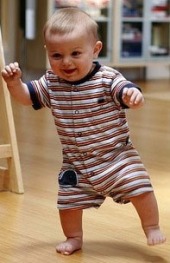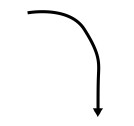How to step.
It’s a much more conscious process than walking:
- Feet together
- Bend knees slightly
- Bending even more, start to extend a foot
- Bending even more, place the foot (generally the heel, if moving forwards; the toes, if moving backwards; toes or heel, if stepping sideways).
The main point is that you keep dropping in order to step, and what most people do is to drop, then stop dropping, and then stick the foot out (forwards, backwards, sideways).
Why keep dropping?
This is easiest to understand if you have someone else to help you.
Assuming that you’re about to try to step forwards, you need someone to push gently against your chest (or if fold your arms across your chest, your partner can push your arms).
If you try to move directly into him/her, it’s just a case of the strongest person ‘winning’ – it’s yang against yang.
However, if you start to drop the body, the person pushing you suddenly finds that his push is no longer going in his intended direction; instead of pushing forwards, he is also starting to push downwards, which will help you to root yourself.
Solo Tai Chi form.
Because no one is pushing you when you do a solo form, it’s easy to get lazy and ignore the above. But it is essential that you do exactly the same, imagining that someone were there, trying to move you against your intention.
If, as normally happens in a tai chi movement, you are also rotating the body, this becomes even more difficult for someone who is attempting to push you, as the body now begins to move on several planes simultaneously. Not only is the body dropping on the vertical, it is also rotating either clockwise or anticlockwise; and if the body is also retreating/advancing as well, it is very hard for your partner to get to grips with where you are and to find your centre in order to push you successfully.
Why do I need to step properly, as I never work with a partner?
You don’t. But it depends on whether or not you want to experience your body working as a whole – unified.
When everything works together, movement becomes very easy; it feels as though you are ‘moving like clockwork’. The expression is appropriate because, when one part of you stops moving whilst everything else continues to move, your body is behaving like an analogue clock inside which one cog goes on strike, and yet you expect the other cogs to carry on normally!
So keep on sinking as you step.
Tai chi and qigong classes with James Drewe at http://www.taiji.co.uk/classes.

In move 1 of the 24, ‘the photo opportunity’, the sinking must start as you peel the foot off the ground?
LikeLike
Very good point.
In the 24-step you shouldn’t bend the knees to move the foot sideways in the “Preparation”; in the 108-Step (Long Form) you do.
At the beginning of the 24-Step, you shift the weight on to the right foot, and extend the left toes in order to step to a shoulder’s width. You don’t bend the right knee.
There’s a reason for this. If you bend the knee, there is a bigger chance of your over-stepping to the left, whereas if you do it as described above, there is no chance at all of over-stepping.
I’ve seen the Preparation step referred to as ‘raising the spirit’; so when you take the weight on to the right foot, you should feel as though you are ‘growing taller’ (without trying to do so). It’s a little like you’re about to have your photo taken and you ‘stand tall’.
This is what I’ve been taught by several teachers (mostly Chinese, and some English). If you bend the knees to step, you are introducing a feature from the 108 which, in my understanding, shouldn’t be there.
Having said that, I’ve seen people doing all sorts of things with the 24-Step that have been drawn directly out of the 108-Step.
LikeLike